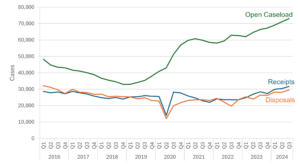Introduction
Why we did this review
1.1 Between April and June 2024, HM Courts and Tribunals Service (HMCTS) and the Ministry of Justice (MoJ) identified inaccuracies in the Crown Court data that are used to produce HMCTS’s monthly management information and MoJ’s quarterly accredited official statistics on the criminal court system in England and Wales. HMCTS and MoJ identified that some closed cases in the Crown Court data were inaccurately reported as open on the Common Platform case management system, and some open cases were inaccurately reported as closed.
1.2 MoJ subsequently cancelled the June and September 2024 statistics releases and HMCTS stopped using the data internally. Since then, HMCTS and MoJ have worked together to investigate and resolve issues with the quality of the data used to report the Crown Court caseload.
1.3 Due to the concerns about the inaccuracies in the Crown Court data, we undertook a review of the quality of MoJ’s criminal court statistics against the Code of Practice for Statistics. Our review considered whether MoJ should continue to publish the statistics as accredited official statistics.
1.4 We also considered HMCTS’s and MoJ’s work to align the methodologies that they use to produce the management information and official statistics, known as the ‘One Crown’ project (One Crown). Until recently, HMCTS and MoJ maintained two separate versions of the data, which affected coherence. The One Crown quality improvement work has created a single and consistent dataset.
Back to topCriminal court statistics for England and Wales
1.5 MoJ’s criminal court statistics include figures on the type, volume and timeliness of cases that are received and processed in the magistrates’ courts and Crown Court. Less serious offences, such as minor theft or traffic violations, are handled entirely in magistrates’ courts. More serious offences, such as robbery or homicide, are passed via the magistrates’ court on to the Crown Court, either for sentencing or for a trial with a jury and a judge.
1.6 One of the main uses of the statistics is in monitoring the open caseload in the criminal courts. Since 2018, the open caseload in the Crown Court has grown steadily, reaching over 73,000 open cases in the period from July to September 2024 (Figure 1). The magistrates’ courts also have a large open caseload.
1.7 The National Audit Office, in its May 2024 report on reducing the backlog in the Crown Court, identified various factors that contributed to the increase in the Crown Court open caseload, including the rise in more-complex cases (particularly sexual offences cases), delays due to the COVID-19 pandemic, a shortage of legal professionals and a decline in court productivity. MoJ told us that the persistent increase in demand on the Crown Court and the 2022 Criminal Bar Association strike also contributed to the increase.
Figure 1. Crown Court caseload in England and Wales, Q1 2016 to Q3 2024.
Back to topCriminal court administrative data systems
1.8 The criminal court official statistics are produced using administrative data from criminal court case management systems. Since 2023, all criminal courts in England and Wales have used Common Platform, a digital case management system that stores all the information about a case in one place and allows a case to be tracked from end to end. Common Platform replaced the existing case management systems for the Crown Court (Xhibit) and magistrates’ courts (Libra).
1.9 Some functionality on Common Platform still needs to be rolled out. Therefore, some new cases are still created on Xhibit and Libra. Since December 2023, approximately 20% of Crown Court case receipts have been processed in Xhibit, although this number is rapidly decreasing. HMCTS expects to decommission Xhibit and Libra in 2026 or 2027.
Back to topOur approach
1.10 For this review, we examined:
- how MoJ and HMCTS identified and investigated the Crown Court data inaccuracies
- how MoJ and HMCTS resolved the data inaccuracies
- the approach and impact of MoJ’s and HMCTS’s wider work to improve data quality (the ‘One Crown’ project)
1.11 We also reviewed the data against related areas of quality in the Code of Practice for Statistics, including the clarity and completeness of MoJ’s publicly available quality information, recent improvements to statistical processes for Crown Court and magistrates’ court data, and the development of new statistics.
1.12 We gathered evidence by speaking to data, analysis and operations teams within MoJ and HMCTS, including:
- the MoJ criminal court statistics lead and Deputy Director for Courts and People Statistics and Analysis
- HMCTS data, analysis and insight deputy directors
- the HMCTS Common Platform team
- HMCTS and MoJ data engineers
1.13 We reviewed all materials published as part of the official statistics releases, including the statistical bulletins, quality statement and guide to criminal court statistics. We also reviewed HMCTS’s and MoJ’s internal documents about the data validation and assurance work and the ‘One Crown’ project.
1.14 Concurrently with our review, the Lord Chancellor and Minister of State for Justice commissioned KPMG to carry out an external review of the methodology and process that MoJ uses to produce the Crown Court caseload statistics. We had several meetings with the KPMG review team and the MoJ statistics team to discuss the scope of the two reviews and emerging findings.
Back to top

